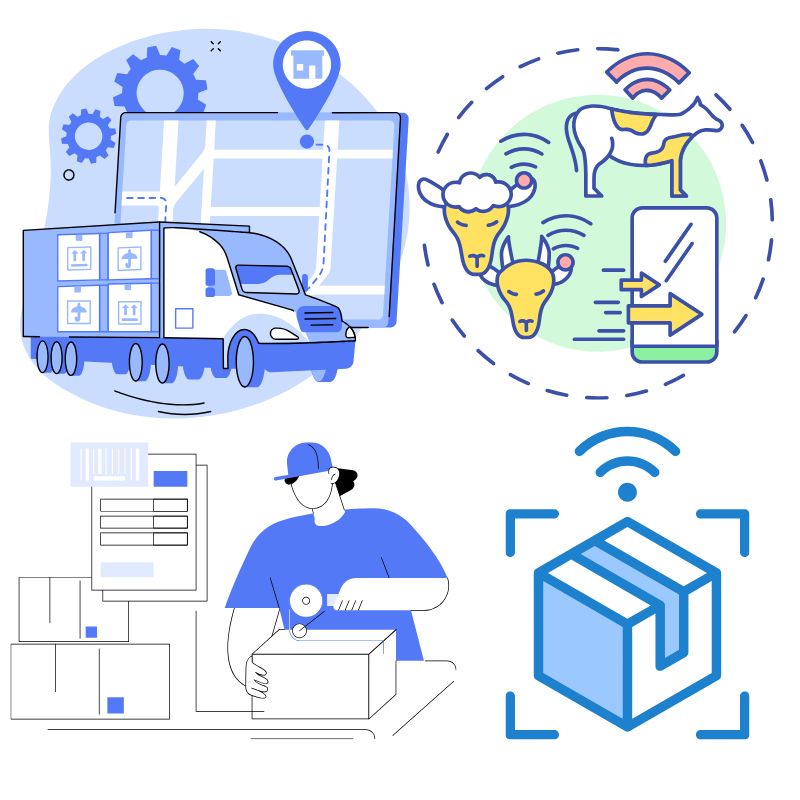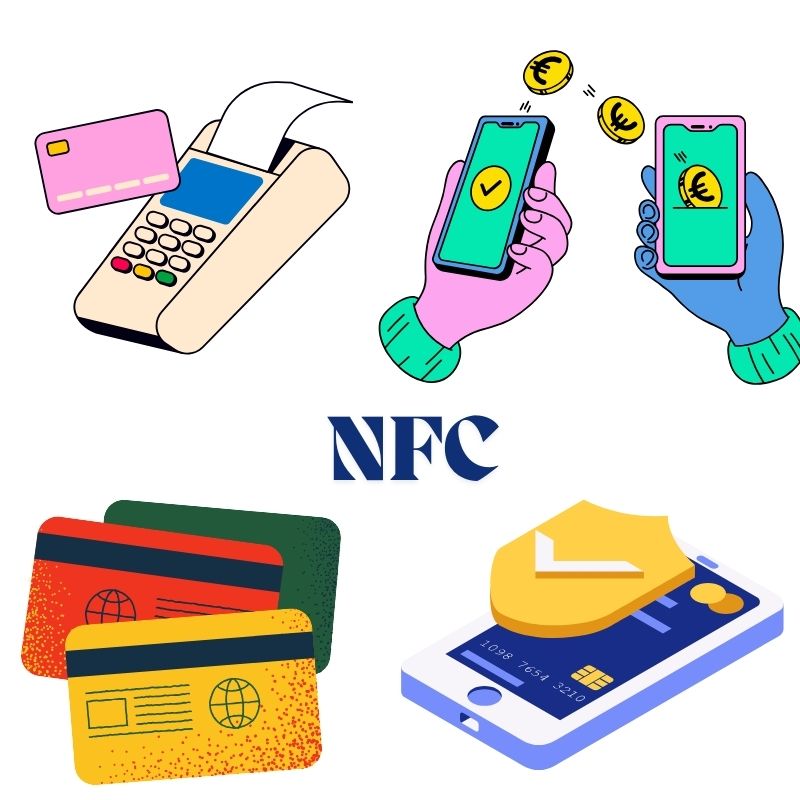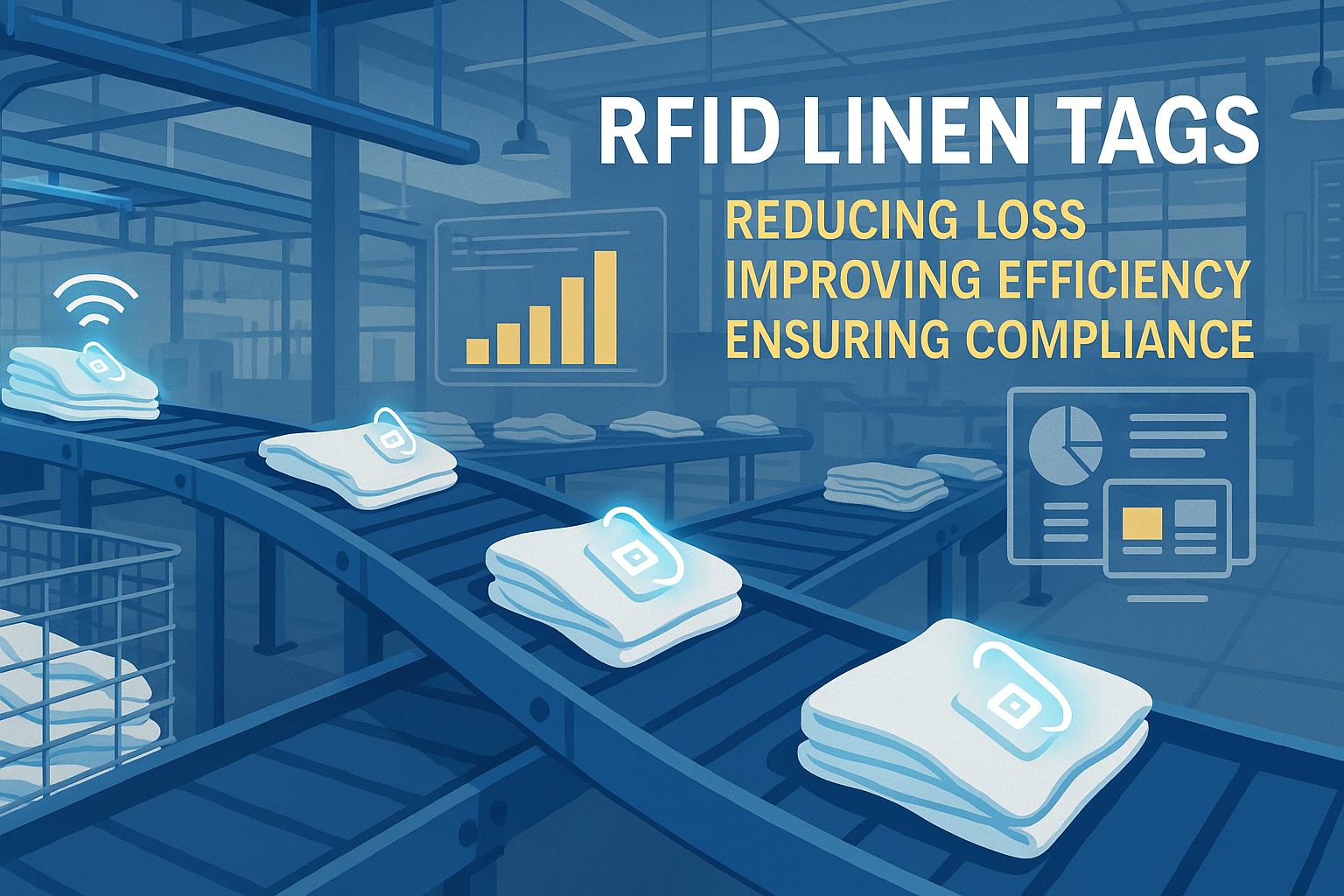
Qual é a diferença entre NFC e RFID?
Índice
NFC e RFID: Principais diferenças, aplicações e qual escolher (Guia 2025)
Desde o acompanhamento de inventário até pagamentos sem contacto, estes métodos de comunicação sem fios estão a ajudar as indústrias a automatizar processos, reduzir erros e aumentar a segurança.
Este guia explica a diferença entre RFID e NFC, como funcionam, as suas aplicações e qual delas se adapta melhor às suas necessidades em 2025.

O que são RFID e NFC?
RFID (Identificação por radiofrequência)
A RFID utiliza ondas de rádio para identificar e rastrear automaticamente objetos através de etiquetas RFID e leitores RFID. É comumente utilizada em setores como logística, retalho, manufatura e saúde para rastrear ativos e otimizar as operações da cadeia de abastecimento.
- Bandas de frequência: Baixa (LF), Alta (HF) e Ultra-Alta (UHF)
- Alcance de leitura: até 100 metros (etiquetas ativas)
- Tags: Passivo (sem bateria) ou Ativo (alimentado por bateria)
- Casos de uso: Gestão de inventário, rastreamento de ativos, controlo de acesso
NFC (Comunicação de Campo Próximo)
NFC é um subconjunto especializado de RFID, operando a 13,56 MHz (HF). Ao contrário do RFID geral, o NFC permite a comunicação bidirecional entre dispositivos a uma distância muito curta — normalmente inferior a 4 cm. É amplamente utilizado para a troca segura e rápida de dados, como pagamentos móveis ou cartões de visita digitais.
- Banda de frequência: Alta frequência (13,56 MHz)
- Alcance: Dentro de alguns centímetros
- Interatividade: Suporta comunicação bidirecional
- Casos de uso: pagamentos sem contacto, emparelhamento de smartphones, transporte público
NFC vs RFID: Qual é a diferença?
A diferença entre RFID e NFC reside no alcance, interatividade, potência e aplicações. Aqui está uma tabela comparativa rápida:
| Recurso | RFID | NFC |
|---|---|---|
| Banda de frequência | Baixa frequência, alta frequência, UHF | HF (13,56 MHz) |
| Faixa de leitura | Até 100 metros | Dentro de alguns centímetros |
| Comunicação | Mão única (principalmente) | Bidirecional |
| Fonte de energia | Passivo ou ativo | Normalmente passivo |
| Aplicações | Inventário, cadeia de abastecimento, controlo de acesso | Pagamentos móveis, partilha de dados |
| Interatividade | Baixo | Alta (interação utilizador-dispositivo) |
- “A RFID é ideal para rastreamento de ativos em grande escala, enquanto a NFC foi projetada para interações seguras de curto alcance, como pagamentos móveis.”
Como funciona a tecnologia RFID
Um sistema RFID depende de três componentes principais:
- Etiquetas RFID: Armazenam informações sobre os itens (podem ser somente de leitura ou de leitura/gravação).
- Leitor RFID: Emite um sinal para alimentar etiquetas passivas e recuperar dados.
- Sistema de software: Interpreta e gere os dados recolhidos.
Tipos de etiquetas RFID
- Etiquetas RFID passivas: Sem bateria interna, alimentadas pelo sinal do leitor RFID.
- Etiquetas RFID ativas: possuem sua própria fonte de alimentação para maior alcance e atualizações frequentes de dados.
Os leitores RFID e NFC estão disponíveis em formatos portáteis e fixos, dependendo da aplicação.
Como funciona a NFC
A tecnologia NFC permite a comunicação de curto alcance entre dois dispositivos compatíveis com NFC ou entre um dispositivo e uma etiqueta NFC.
Vantagens do NFC:
- Simplicidade do Tap-and-Go: Não é necessário emparelhar ou digitalizar.
- Alta segurança: Ideal para transações financeiras sem contacto.
- Comunicação bidirecional: Ao contrário da maioria dos sistemas RFID, os dados podem fluir em ambas as direções.
Os dispositivos leitores NFC e RFID estão cada vez mais integrados em smartphones, terminais POS e portões de trânsito para interações rápidas, fiáveis e seguras.
Aplicações de RFID
RFID e NFC alimentam diversas aplicações, mas o longo alcance e a flexibilidade da RFID tornam-na ideal para:
Gestão de inventário
- Atualizações em tempo real
- Rastreamento automatizado em todos os armazéns
Rastreamento de ativos
- Monitorizar equipamentos médicos, ferramentas ou veículos
- Aumente a eficiência na logística e nos cuidados de saúde
Controle de acesso
- Use cartões-chave RFID, chaveiros ou crachás
- Controle a entrada para proteger edifícios ou zonas
Aplicações do NFC
Os recursos seguros e de curto alcance da NFC se destacam em aplicações pessoais e voltadas para o público:
Pagamentos Móveis
- Apple Pay, Google Pay, Samsung Pay.
- Transações seguras em segundos.
Dispositivos inteligentes e marketing
- Toque para iniciar aplicações ou partilhar informações de contacto.
- Etiquetas inteligentes para informações sobre produtos ou check-ins.
Sistemas de Transporte
- Cartões de transporte sem contacto.
- Embarque fácil nas redes de metro e autocarro.

NFC vs RFID: Qual deve usar?
| Caso de uso | Melhor Tecnologia |
|---|---|
| Rastreamento de longo alcance | RFID |
| Operações de inventário ou cadeia de abastecimento | RFID |
| Transações seguras e pessoais | NFC |
| Pagamentos móveis e identificação | NFC |
| Automação inteligente IoT | Ambos |
Se você gerencia milhares de ativos, a RFID é a sua melhor opção. Para interações individuais e seguras, como tocar no seu telefone, a NFC é a escolha certa.
NFC e RFID na IoT (Internet das Coisas)
RFID e NFC são fundamentais para os ecossistemas de IoT, permitindo que objetos físicos “comuniquem” com sistemas digitais.
- RFID na IoT: Monitoriza mercadorias em cadeias de abastecimento e fábricas.
- NFC na IoT: Permite o emparelhamento seguro de dispositivos, acesso à casa inteligente e controlo em tempo real através de smartphones.
“A combinação de etiquetas NFC e RFID está a transformar a IoT ao conectar ativos físicos à nuvem.”
O papel da frequência no desempenho da NFC e da RFID
Compreender a frequência ajuda a escolher o sistema certo:
- LF (125–134 kHz) – Curto alcance, utilizado no controlo de acesso
- HF (13,56 MHz) – Utilizado tanto por RFID como por NFC
- UHF (860-960 MHz) – Longo alcance, ideal para cadeias de abastecimento
Cada frequência suporta diferentes intervalos e velocidades de leitura, tornando a seleção do leitor RFID e NFC importante para o desempenho do sistema.
Perguntas frequentes sobre NFC e RFID
Qual é a principal diferença entre RFID e NFC?
A NFC é um subconjunto da RFID. Enquanto a RFID suporta comunicações de longo alcance e unidirecionais, a NFC foi concebida para interações bidirecionais de curto alcance.
As etiquetas NFC e RFID podem ser utilizadas de forma intercambiável?
Nem sempre. A NFC opera apenas em HF, enquanto a RFID pode usar LF, HF ou UHF. As etiquetas NFC funcionam apenas com leitores NFC, não com todos os leitores RFID.
As etiquetas RFID são seguras?
As etiquetas RFID passivas podem ser vulneráveis sem encriptação. A NFC oferece mais segurança integrada, especialmente para transações financeiras.
O que é um leitor NFC e RFID?
É um dispositivo utilizado para ler etiquetas RFID ou NFC. Muitos smartphones modernos funcionam como leitores NFC para ações sem contacto.
Como funcionam os pagamentos com NFC?
Os dispositivos utilizam NFC para transmitir informações de pagamento encriptadas sem fios para terminais compatíveis — sem necessidade de contacto físico.
Quais setores se beneficiam mais da RFID?
O retalho, os cuidados de saúde, a logística, a produção e o armazenamento utilizam a RFID para automatização e visibilidade.
Considerações finais
Tanto a RFID como a NFC oferecem um valor significativo, quer esteja a rastrear paletes ou a efetuar pagamentos com o seu smartphone. A sua escolha deve estar alinhada com as suas necessidades operacionais:
- Para um rastreamento abrangente e automatizado, escolha RFID.
- Para interações seguras e de curto alcance, opte pelo NFC.
À medida que as etiquetas RFID e NFC evoluem com a IoT, agora é o momento perfeito para integrá-las ao seu fluxo de trabalho.
Precisa de ajuda para escolher o sistema NFC ou RFID certo para o seu negócio?
Contate-nos hoje mesmo ou explore a nossa gama completa de leitores e etiquetas NFC e RFID.

Raio Zhou
Este artigo foi escrito por Ray Zhou, um especialista em tecnologia RFID com mais de 10 anos de experiência no sector.
Comentários
Produtos quentes

O que é a gestão de resíduos por RFID
Imagine uma cidade onde todas as lixeiras falam — não literalmente — mas através de um pequeno chip que informa ao sistema quando estão cheias, quando são esvaziadas e para onde vão. É isso que a gestão de resíduos por RFID está a fazer hoje.

O que são vedantes de parafuso e suas aplicações? | Guia completo
No comércio global e na logística, os selos de segurança desempenham um papel crucial para garantir a segurança e a conformidade da carga. Estes pequenos mas poderosos dispositivos foram concebidos para bloquear contentores de transporte, reboques e portas de carga com um mecanismo inviolável.

O que é um protetor de cartões RFID? Benefícios, casos de uso e guia de compra
A tecnologia RFID (identificação por radiofrequência) está em todo o lado: nos seus cartões de crédito, cartões de identificação, passes de trânsito, chaves de quartos de hotel e muito mais. Oferece rapidez e conveniência, mas também abre a porta a um novo tipo de roubo digital chamado "skimming". É aí que entra um protetor de cartões RFID.

Pulseiras RFID para eventos: Guia de compra a granel para organizadores
As pulseiras RFID para eventos estão a tornar-se a solução ideal para os organizadores que necessitam de entradas mais rápidas, prevenção de fraudes e pagamentos sem dinheiro em concertos, festivais e recintos desportivos. Ao contrário dos bilhetes em papel ou dos códigos QR, estas pulseiras inteligentes utilizam chips incorporados para agilizar o acesso, proteger as transacções e melhorar a experiência dos convidados.

Como a etiqueta RFID no para-brisas melhora o controlo de acesso de veículos e os sistemas de portagens
No mundo acelerado de hoje, a identificação de veículos tem de ser rápida, segura e sem contacto. Uma etiqueta RFID no para-brisas proporciona exatamente isso - uma forma fiável de gerir a cobrança de portagens, o estacionamento e o acesso a portões sem parar os veículos.

As vantagens das etiquetas RFID para roupa de cama na lavandaria comercial
Gerir a lavandaria em hospitais, hotéis ou grandes serviços de lavandaria é uma tarefa importante. Todos os dias, milhares de lençóis, toalhas e uniformes são lavados, separados e enviados de volta. Mas problemas como lençóis perdidos, erros de separação e contagem manual podem custar muito dinheiro às empresas. Por exemplo, os hotéis de média dimensão podem perder mais de $200.000 por ano devido à falta de roupa de cama.
É aí que entram as etiquetas RFID para roupa de cama.
Etiquetas
BLOGS RELACIONADOS

O que é a gestão de resíduos por RFID
Imagine uma cidade onde todas as lixeiras falam — não literalmente — mas através de um pequeno chip que informa ao sistema quando estão cheias, quando são esvaziadas e para onde vão. É isso que a gestão de resíduos por RFID está a fazer hoje.

O que são vedantes de parafuso e suas aplicações? | Guia completo
No comércio global e na logística, os selos de segurança desempenham um papel crucial para garantir a segurança e a conformidade da carga. Estes pequenos mas poderosos dispositivos foram concebidos para bloquear contentores de transporte, reboques e portas de carga com um mecanismo inviolável.

O que é um protetor de cartões RFID? Benefícios, casos de uso e guia de compra
A tecnologia RFID (identificação por radiofrequência) está em todo o lado: nos seus cartões de crédito, cartões de identificação, passes de trânsito, chaves de quartos de hotel e muito mais. Oferece rapidez e conveniência, mas também abre a porta a um novo tipo de roubo digital chamado "skimming". É aí que entra um protetor de cartões RFID.




